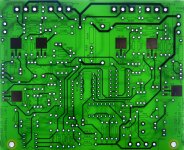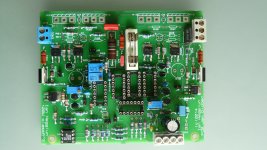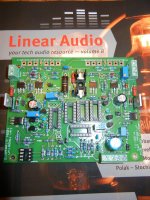With the publication of Linear Audio, Volume 8, I would like to initiate a builder's thread and discussion in regard to Ian Hegglun's new cube-law design.
One PCB, enough for a single channel, is included with Volume 8. Extra PCBs, links to simulation files, supplementary documents, parts lists, and BOM may be found on my website: Greenchild
I plan on documenting my own build within the next several weeks.
One PCB, enough for a single channel, is included with Volume 8. Extra PCBs, links to simulation files, supplementary documents, parts lists, and BOM may be found on my website: Greenchild
I plan on documenting my own build within the next several weeks.
Attachments
I'm ahead of you guys 
I must, to my chagrin, call your attention to an incorrect footprint on the silk screen.
No show stopper, but be aware.
Details here. My bad.
Jan
I must, to my chagrin, call your attention to an incorrect footprint on the silk screen.
No show stopper, but be aware.
Details here. My bad.
Jan
Attachments
I'm ahead of you guys
Very nice, Jan! I will be close behind you!
I'm ahead of you guysJan
Jan, is that R49 next to Q8? The "9" is covered by the footpad? I notice you have a 1.2M resistor in there, although the BOM specifies 1M for R49.
In any regard, I'm stuffing 1M in there.... Hopefully my assumption is correct.
Jan, is that R49 next to Q8? The "9" is covered by the footpad? I notice you have a 1.2M resistor in there, although the BOM specifies 1M for R49.
In any regard, I'm stuffing 1M in there.... Hopefully my assumption is correct.
Yes correct on both counts. I had the same question on R49 to Ian, and both will work since there is anyway the series trimmer to adjust.
Jan
Yes correct on both counts
Thanks, Jan.
I also noticed that there are only two holes for D3, although the Bi-Color LED has three legs.... How does that work?
Thanks, Jan.
I also noticed that there are only two holes for D3, although the Bi-Color LED has three legs.... How does that work?
I used a 2-pin bicolor LED for the schematic and PCB....
Here's one from knightsbridge.
But you can use two separate LEDs by connecting them in // but opposite polarity. Gives you a choice of colors
Jan
Attachments
Last edited:
I can get a 214mm x 76mm x 33mm. The depth is a little shy (33mm v.s. 48mm). Does anyone see a problem with this size over Ian's choice (200mm x 75mm x 48mm).
Bigger is always better; if in doubt, go big.
Check out this supplier. You can specify the depth. If you match Ian's volume than you should be OK:
8.460" Wide Extruded Aluminum Heatsink - HeatsinkUSA, LLC Store
A blackbody also radiates heat much better.... maybe you could have them anodized black?
I used a 2-pin bicolor LED for the schematic and PCB....
Thanks, Jan. Ian recommend I go with this one on Mouser:
Lumix part #SSL-LX3353IGW
Mouser part #696-SSL-LX3353IGW
I've also updated my BOM and Mouser parts project to correct a few errors that I made.
Unconventional and thought provoking ! This is another Ian Hegglun classic. The addendum articles are a gem.. I've just turned page after page and there's wisdom dripping off each one - much of his stuff takes a while to digest and perhaps that turns some folks off. I don't know if Ian is on these forums (his articles suggest that he does visit) - if you are : THANK YOU!!
Single-Die Laterals
Ian mentioned in his LA Vol. 8 article that single-die laterals may be used in place of dual-die laterals. Because I happen to have a lot of single-die Exicon ECX10N20R's and ECX10P20R's on hand, I'm going to use them in my build.
Ian was graciously kind enough to provide me with an updated schematic for parallelling the single-die laterals. Please see attached PDF.
Ian mentioned in his LA Vol. 8 article that single-die laterals may be used in place of dual-die laterals. Because I happen to have a lot of single-die Exicon ECX10N20R's and ECX10P20R's on hand, I'm going to use them in my build.
Ian was graciously kind enough to provide me with an updated schematic for parallelling the single-die laterals. Please see attached PDF.
Attachments
A very interesting and thought-provoking idea! But isn't the general principle of the square and cube law amps just to lower the order of the output stage harmonic distortion so that global feedback will correct it better?
Using the same lateral MOSFETs in a regular emitter follower output stage with hot bias, wouldn't we get a broad, flattish crossover region that also generated mostly low order distortion?
JM2C, those were the thoughts provoked in me
Using the same lateral MOSFETs in a regular emitter follower output stage with hot bias, wouldn't we get a broad, flattish crossover region that also generated mostly low order distortion?
JM2C, those were the thoughts provoked in me
A class A amp being linear has to be biased at the mid-point of the max output current in class A. With square or cube law devices, you can bias them (much) lower and still have a class A output stage.
So the basic idea, very short, is class A operation at 1/3rd or less of the dissipation.
Jan
So the basic idea, very short, is class A operation at 1/3rd or less of the dissipation.
Jan
Yes, I get that part. I am inviting you to take one step back and ponder issues like these:
Is it really Class A? I guess it is, in the sense that neither half of the output stage ever stops conducting. But the sum of the device currents is no longer constant, and there must be more distortion than a "true" Class-A output stage, because the transfer function is now a curve, not a straight line.
What does it achieve that a high biased Class-AB output stage doesn't? Freedom from crossover distortion you might say. But I'd argue that the square- or cube-law output stage is simply broadening the crossover region until it covers the whole output voltage swing. You have not got rid of the crossover distortion, just lowered the order of it. Douglas Self discovered that an emitter follower output stage with lots of parallel devices and low-value emitter resistors did the same thing: flatten and widen the gain hump in the crossover region.
I suppose one valuable thing the square-and cube-law amps do is make the bias setting completely non-critical. The transfer functions of the output stage halves are smooth curves, so they overlap to form a smooth function almost irrespective of the offset between them. But then Cordell claims this to be the case with MOSFET output stages too and provides some evidence in his book to back it up.
Is it really Class A? I guess it is, in the sense that neither half of the output stage ever stops conducting. But the sum of the device currents is no longer constant, and there must be more distortion than a "true" Class-A output stage, because the transfer function is now a curve, not a straight line.
What does it achieve that a high biased Class-AB output stage doesn't? Freedom from crossover distortion you might say. But I'd argue that the square- or cube-law output stage is simply broadening the crossover region until it covers the whole output voltage swing. You have not got rid of the crossover distortion, just lowered the order of it. Douglas Self discovered that an emitter follower output stage with lots of parallel devices and low-value emitter resistors did the same thing: flatten and widen the gain hump in the crossover region.
I suppose one valuable thing the square-and cube-law amps do is make the bias setting completely non-critical. The transfer functions of the output stage halves are smooth curves, so they overlap to form a smooth function almost irrespective of the offset between them. But then Cordell claims this to be the case with MOSFET output stages too and provides some evidence in his book to back it up.
Last edited:
But the sum of the device currents is no longer constant, and there must be more distortion than a "true" Class-A output stage, because the transfer function is now a curve, not a straight line.
Yes, now we have soft clipping.
- Home
- Amplifiers
- Solid State
- Ian Hegglun's ClassA^3 Cube-Law Amp


